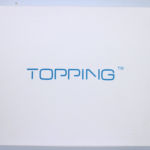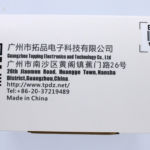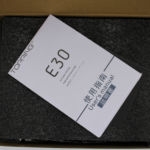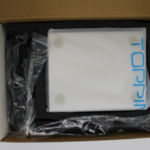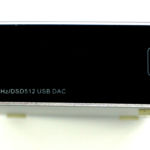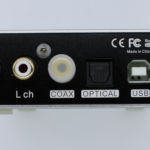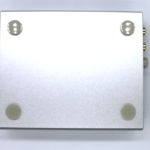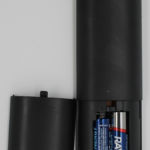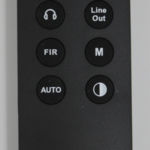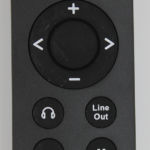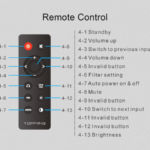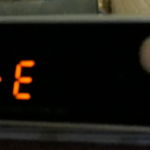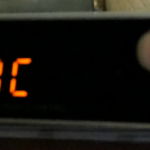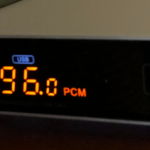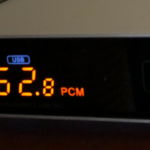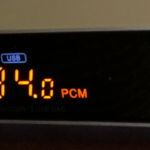Topping E30
Disclaimer: I was approached by HiFiGo about reviewing the Topping E30 and quickly agreed. Those familiar with Topping will know they have been producing a line of desktop products that outperform just about everything in their price range and measure extremely well. They have received praise from a number of sources for their DACs in particular so when the opportunity came up to try the latest release, how could I pass that up. I have no financial interest in HiFiGo or Topping and have received no compensation save the product itself for this review. If you are interested in further information, please visit the Topping Website. To purchase the E30, see Hifigo.com or their AliExpress Store.
Unboxing:
The E30 comes in a small lift-top box with the topping name on top and the model name on the side along with Topping’s address. If you weren’t already familar with what you were getting, the box would do little to encourage a purchase and is very obviously more about transport than marketing the product. Inside the box a small closed cell foam surround protects the unit and keeps it separate of the cables, and remote that come with it. The two cables provided are a USB Type-A to barrel connector for 5Volt DC power, and a standard USB Type-A male to Type-B male for data communication. This was my first introduction to the USB-power connector cable and while it does make some sense, I question why they didn’t simply incorporate power into the data communication on one hand or provide a wall adapter for the provided cable on the other. I suspect the answers are that separate power is cleaner, and that this is a budget product so some cost cutting is to be expected.
Build:
The E30 is a small footprint affair with an aluminum case and glass front and rear plates. The display is 2 color on the front and a single on/off button is to the right of the main display. On the reverse we have a power input, usb input, optical input, and Coaxial input, followed by a pair of RCA jacks for output. The bottom of the case does have feet installed to keep it from scratching other surfaces and help prevent it sliding around. The unit is extremely lightweight so is best placed in an area where it isnt subject to bumps and bangs as it will move easily. With this designed ot be used with the provided remote handling the configuration duties, it is likely to end up on the Stereo rack or desktop and not touched much during use.
Internals:
For such a simple looking little box, there is a lot going on here. Inputs start with either a 2nd generation Xmos 208 chip for USB duties, or the AK4118 receiver chip for s/pdif. Right off the bat, you can tell where the main focus is as USB input supports up to 32bit/768kHz PCM, DSD512(native at that), and DoP up to 256. The Coaxial and optical inputs by comparison only support PCM and only to 24bit/192kHz, so to get the most out of the E30, you’ll need to use USB input. It should be noted that a driver is needed for windows PCs in order to reach above 24/192 which is detected by default when the E30 is connected via USB. Next in the signal path is the AK4493 DAC chip. This is the workhorse of the AK line and while no longer considered a flagship, it has very respectable performance with a listed distortion of -113dB and a dynamic range of as high as 126dB. It should be noted that the dynamic range spec is for mono mode, and since the E30 does not use dual chips, dynamic range will probably be somewhere close to 114dB which is still quite good. I normally attempt to post pictures of the internals, but with the E30, that is a bit more involved. The rear face is held on with two Torx screws and is easily removed and the board slides part way out but is limited by a cable that runs from the front face to a central location on the board. Inspection shows the front face is also held on with screws and then a glass face mounted over that which means the screw heads are not accessible. I attempted to gently lift the face plate a has been possible on some others to see if I could access the screws but was unable to do so without risking cracking or chipping the glass so I gave up rather than destroy the unit.
Features and Controls:
It is hard to separate the features and the control mechanisms without ending up rehashing most of the same territory so I decided to combine them into a single section. First off, the On/Off. The unit can be turned on from the remote or the front face of the unit, or will automatically switch on when input is detected. I found that allowing USB to turn on the unit worked well but optical sometimes missed the opening note of a track by the time the dac reacted so for me it was best to use the remote to power the unit on and select the input before playing from an optical or coaxial source. This is by no means unique as pretty much every optical input dac I have behaves the same way. The unit can be turned off using the switch, the remote, or just by passing no signal to it for over 60 seconds (when enabled. Auto power on/off setting is controlled by the bottom left button on the remote labeled AUTO. Also worth noting here again is the this unit will not power on using only the USB input cable. It MUST have an external power source in addition to a data connection even when using USB for both.
Once on, pretty much all the controls are handled via the remote. It is important to recognize that Topping uses the same remote with several different models so not all buttons are applicable here. Starting down the left side of the remote, we have the power button in Red, the wheel which we will cover shortly as it has multiple functions, the headphone button which is unused, the FIR button which sets the dac filter modes, and the Auto button that was previously mentioned.
The FIR button allows the user to switch between 6 filter modes for PCM and 2 for DSD. PCM filter modes are: F-1 Sharp, F-2 Slow, F-3 Short Delay Sharp, F-4 Short Delay Slow, F-5 Super Slow, and F-6 Low dispersion Short delay. When in DSD mode the two options are F-1 39kHz ofr F-2 76kHz.
Sound
This is always the hard part, partially because a great dac should contribute nothing, and partially because unless you know the rest of the audio chain extremely well, it is easy to falsely attribute characteristics of other components to the the DAC. I used my Auris Euterpe and Sennheiser HD800 for the bulk of my testing with the Burson Swing/Fun pairing used as well for A/B testing of the Swing vs the E30. When using the the Burson Gear, I paired them with the He560 v1 since it works beautifully when paired to the power of the Fun.
The first thing I noticed comparing the internal dac of the Euterpe to the E30 is that it is a bit fuller particularly in the mids and a touch warmer and smoother as well. This is not atypical of ESS vs AKM comparisons as the AKMs tend to be a bit smoother and warmer but fall short of wringing out that last detail that the ESS rivals deliver. Having said that, I didn’t feel the E30 was lacking in the detail either and could not detect a step back from what had been presented using the internal dac. Warmer yes, a bit thicker yes, but less detailed, no. The E30 delivers some micro-detail but you do have to look for it. When compared to the Burson Swing, the Swing definitely delivers more detail, but not without being a bit thinner in the mids and a bit more clinical sounding in the overall. Overall I give the E30 high marks for having a very natural tonality and good speed so transients are well rendered provided the rest of the gear is up to the challenge.
I have always thought stage was more a function of the headphone than any other part of the chain and while I still hold that view, I will say that other components can detract from it. The E30 did a bit when paired with the HD800 and its legendary stage. This was where I found the issue with power supply most on display. Poor power gave me a less than expected stage size and detracted from the music. Using the Ipower returned my HD800 to its normal cavernous sound. I don’t feel the E30 did anything to detract from the stage size when adequately powered, when it was suffering from power issues, it is obvious.
Overall, I felt the E30 was a little rolled off at the top end compared to the Swing but roughly on par with the Euterpe which puts it in pretty good company. At the low end, the E30 had good thump, slam and rumble and no trouble at all delivering all the low end you would hope for. Mids as already mentioned have good body and a very natural tonality that was particularly enjoyable for strings.
USB Power
One thing became readily apparent as I did my testing. The E30 is as good or bad as the power it is fed. I tried using my laptop as the power source and it was markedly worse than using a separate USB (1.4A), which was in turn not as good as using the iFi Ipower. I would highly recommend you not judge the E30 based on using the provided power cable plugged into a laptop or wall-wart without some form of power conditioning as it does the E30 a great disservice to do so.
Comparisons
Topping has been releasing some killer dacs and dac amps in recent years and has pushed the rest of the budget market hard to keep up and it is starting to show as recently we have seen several really good budget DACs. Some are more DIY such as the Khadas Toneboard, while others come from other Chinese vendors like SMSL with their 10th anniversary Sanskrit model, and still others from value oriented American brands like Schiit Audio with their Modi 3 release. Buyers can expect to get a lot for their dollar these days even in the sub-$200 market.
E30 vs Khadas TB – The E30 is definitely the more polished product here as the Khadas is a DIY affair that you will need to buy a case for separately. Having said that, by the time you make or purchase a case, these two are roughly equal on price. The TB lacks the optical input of the E30, but does have USB Type C and coaxial inputs and it can be setup to use an external power supply (5V same as E30) using pins 1 and 21 of the 40 pin header to connect to power. Again, you have to be willing to do some DIY, and again there is an additional cost so realistically you are now paying more for the Tone Board than for the E30. Sound wise, the TB uses a 9038Q2m ESS chip at the heart and sounds a bit thinner in the mids and a bit more analytical. I do think the TB has a slight detail advantage, but that may also be the fact that the thinner brighter signature makes them jump out more. Overall, I think the E30 is the better buy as it comes as a complete package with remote and a more engaging sound signature for less than you will pay to do it yourself with the Tone Board.
The SMSL Sanskrit has been a love/hate relationship for many over the years with some models having stellar specs but poor enough QC that it drove bargain hunters crazy trying to find a good one. The 10th Anniversary model seems to have corrected some of those issues and offers a list of specs in parallel to the E30. Both use the same dac chip, both have a remote, both have all the same input options, and both offer external power input to keep the usb clean. I did find that the tone was fuller and a bit cleaner on the E30. Between Topping’s reputation for reliability and their history of continuing to support their products after the sale and the improved sound quality, I’d call the E30 the winner between these two.
Lastly the American contender, the Schiit Modi 3. these two have similar form factors, both support all three input types, both support external power, and both have all metal construction. What the Modi 3 lacks is DSD support and if you want volume control, you’ll have to add the Sys for an additional $49 and even then, you don’t get a remote in the package. Both have enviable reputations for quality hardware, and both sound excellent with neither pulling dramatically ahead of the other. From a pure value proposition, to get what the E30 offers in the box, you’ll have to spend at least $20 more ($130 for E30 vs $148 for Modi3/sys combo) and you will have to be willing to go without the remote until Schiit offers one. For that reason, I’ll recommend the E30 as it simply sounds as good, measures as well, and offers more versatility than the Modi 3.
Conclusion
Topping has built a reputation for providing products that measure extremely well, sound great, and offer exceptional value. Most of the topping line packs a lot into a small price tag, and the E30 continues that trend. At $130 retail, it is among the least expensive desktop dac models available and packs in features that others at the price point don’t. The E30 is not only a great DAC, but can also be used as a pre-amp with powered monitors or a power amp that doesn’t otherwise offer volume control. Sound quality is very good with a natural tonality that was unexpected; to my ear the E30 tonality is better than the D50s or Dx7. Those more expensive members of the Topping family do have better detail rendering, more power, and more options, but they don’t have an improved tonality. The E30 winds up being an easy recommendation as few options exist that can match it in price, tonality, and feature set. If you decide you want an E30 for yourself, I recommend Hifigo.com or their AliExpress Shop.
-
Packaging - 6/106/10
-
Build Quality - 7/107/10
-
Sound Quality - 7.5/107.5/10
-
UI - 7/107/10
-
Connectivity - 7/107/10
Summary
Pros – Good build, great sound, simple UI, DAC or Pre-Amp mode, remote included in package
Cons – very sensitive to power used, no bluetooth option


